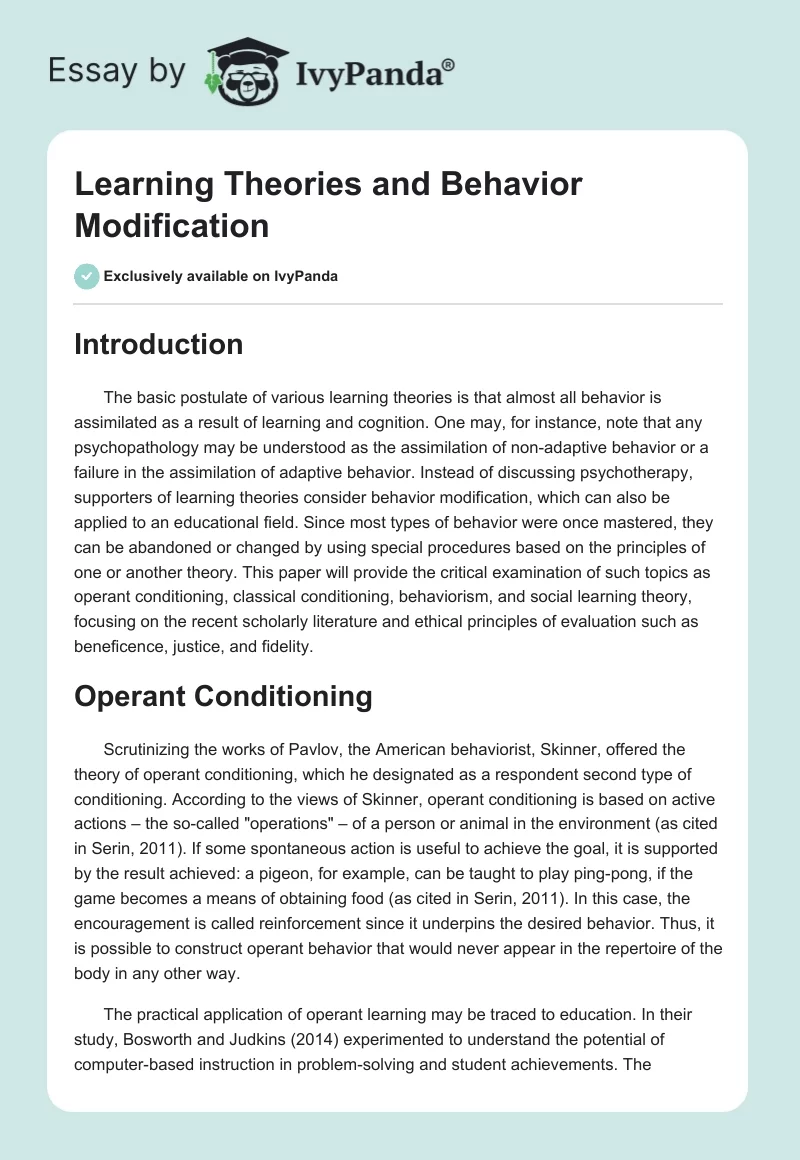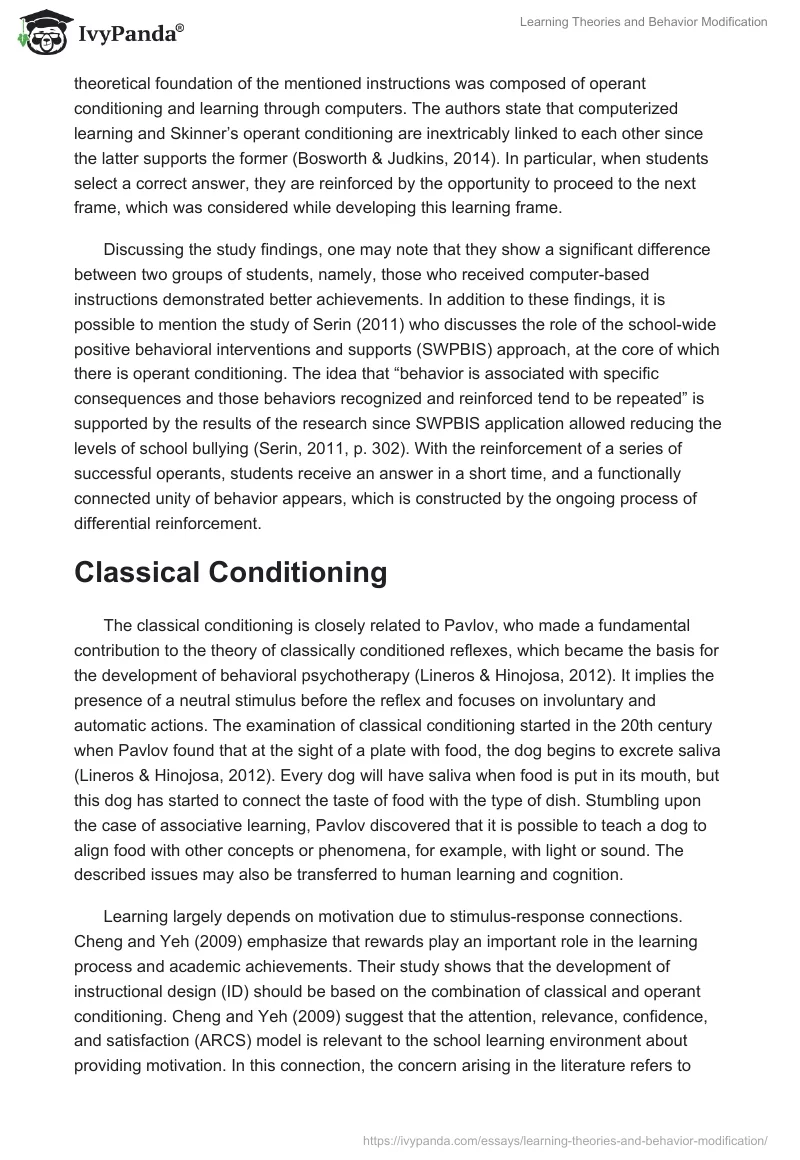Introduction
The basic postulate of various learning theories is that almost all behavior is assimilated as a result of learning and cognition. One may, for instance, note that any psychopathology may be understood as the assimilation of non-adaptive behavior or a failure in the assimilation of adaptive behavior. Instead of discussing psychotherapy, supporters of learning theories consider behavior modification, which can also be applied to an educational field. Since most types of behavior were once mastered, they can be abandoned or changed by using special procedures based on the principles of one or another theory. This paper will provide the critical examination of such topics as operant conditioning, classical conditioning, behaviorism, and social learning theory, focusing on the recent scholarly literature and ethical principles of evaluation such as beneficence, justice, and fidelity.
Operant Conditioning
Scrutinizing the works of Pavlov, the American behaviorist, Skinner, offered the theory of operant conditioning, which he designated as a respondent second type of conditioning. According to the views of Skinner, operant conditioning is based on active actions – the so-called “operations” – of a person or animal in the environment (as cited in Serin, 2011). If some spontaneous action is useful to achieve the goal, it is supported by the result achieved: a pigeon, for example, can be taught to play ping-pong, if the game becomes a means of obtaining food (as cited in Serin, 2011). In this case, the encouragement is called reinforcement since it underpins the desired behavior. Thus, it is possible to construct operant behavior that would never appear in the repertoire of the body in any other way.
The practical application of operant learning may be traced to education. In their study, Bosworth and Judkins (2014) experimented to understand the potential of computer-based instruction in problem-solving and student achievements. The theoretical foundation of the mentioned instructions was composed of operant conditioning and learning through computers. The authors state that computerized learning and Skinner’s operant conditioning are inextricably linked to each other since the latter supports the former (Bosworth & Judkins, 2014). In particular, when students select a correct answer, they are reinforced by the opportunity to proceed to the next frame, which was considered while developing this learning frame.
Discussing the study findings, one may note that they show a significant difference between two groups of students, namely, those who received computer-based instructions demonstrated better achievements. In addition to these findings, it is possible to mention the study of Serin (2011) who discusses the role of the school-wide positive behavioral interventions and supports (SWPBIS) approach, at the core of which there is operant conditioning. The idea that “behavior is associated with specific consequences and those behaviors recognized and reinforced tend to be repeated” is supported by the results of the research since SWPBIS application allowed reducing the levels of school bullying (Serin, 2011, p. 302). With the reinforcement of a series of successful operants, students receive an answer in a short time, and a functionally connected unity of behavior appears, which is constructed by the ongoing process of differential reinforcement.
Classical Conditioning
The classical conditioning is closely related to Pavlov, who made a fundamental contribution to the theory of classically conditioned reflexes, which became the basis for the development of behavioral psychotherapy (Lineros & Hinojosa, 2012). It implies the presence of a neutral stimulus before the reflex and focuses on involuntary and automatic actions. The examination of classical conditioning started in the 20th century when Pavlov found that at the sight of a plate with food, the dog begins to excrete saliva (Lineros & Hinojosa, 2012). Every dog will have saliva when food is put in its mouth, but this dog has started to connect the taste of food with the type of dish. Stumbling upon the case of associative learning, Pavlov discovered that it is possible to teach a dog to align food with other concepts or phenomena, for example, with light or sound. The described issues may also be transferred to human learning and cognition.
Learning largely depends on motivation due to stimulus-response connections. Cheng and Yeh (2009) emphasize that rewards play an important role in the learning process and academic achievements. Their study shows that the development of instructional design (ID) should be based on the combination of classical and operant conditioning. Cheng and Yeh (2009) suggest that the attention, relevance, confidence, and satisfaction (ARCS) model is relevant to the school learning environment about providing motivation. In this connection, the concern arising in the literature refers to adequate motivation as well as the ways to determine and evaluate it (Cheng & Yeh, 2009). In other words, further research is needed to specify the role, potential, and amount of motivation in terms of school learning and cognition. More to the point, there is a need to inform educators of the importance of classical and operant conditioning in the mentioned settings.
Behaviorism
The founder of behaviorism, Watson, proclaimed the need to replace the traditional subject of psychology (psychic phenomena) with a new one (behavior) (Ertmer & Newby, 2013). A subject of behaviorism is not the subjective world of a person, but objectively fixed characteristics of his or her behavior, including all actions, words, and responses, both acquired and congenital. The behavioristic approach is well combined with other contemporary theories of learning and cognition (Ertmer & Newby, 2013). Many modern behaviorists use elements of the gestalt approach and elements of psychoanalysis. For instance, if a client is afraid to fly on airplanes, the behaviorist is likely to launch the standard procedure of desensitization (Ertmer & Newby, 2013). He or she will begin to work out the conditioned reflex of quiet relaxation to the stressful situation of flight. Modifications of behaviorism are widespread in American psychology and are primarily represented by the theory of social learning of Bandura and Rotter.
The focal task of teaching and learning is to provide a student with an understanding of how processes work and connect. In this regard, behaviorism is guided by the possibilities of thinking, its actualization, and development through learning (Ertmer & Newby, 2013). The advantage of the given approach lies in interpreting the learning process as a combination of integral and complex mental structures such as perception and thinking as well as understanding the learning as a process of finding something new. At the same time, Moore (2011) claims that behaviorism exaggerates the role of structural relations in the subject to the detriment of its functional and genetic connections and underestimates the importance of one’s knowledge and creativity.
Thus, in practice, the behavior is the result of learning: a set of reactions to external stimuli, which are mainly absorbed in the learning process. The topic of learning and acquiring skills through trial and error became central to behaviorism, which collected a huge amount of experimental material about the factors that determine the modification of behavior (Moore, 2011). In general, the behavioral approach, despite its shortcomings, has made a significant contribution to the development of psychology and education, primarily in the study of the influence of social factors on the formation of an individual’s personality.
Social Learning Theory
In his studies, Bandura relied on the socio-cognitive theory based on the fact that human behavior is caused by the interaction between the subject (interpretation) and the environment (punishment and response). According to social learning theory, the picture of reality based on which people act is the result of their experience gained from other people – the so-called vicarious experience (Reed et al., 2010). From the social theory of learning, one can apply this knowledge to learning practice in various ways. In particular, a teacher or educator should be perceived by students as an authoritative person, constantly teaching them new verbal, behavioral, and symbolic models (Reed et al., 2010). Efficiency will depend on the consistency of the models, their relevance to the competencies of the students, and the effectiveness of how a teacher or educator will represent these models.
Motivation in learning and cognition is another essential area that should be discussed. Bandura believes that the consequences of behavior such as reinforcements and punishments play a significant role, respectively, in strengthening or weakening one or another type of behavior (as cited in Pratt et al., 2010). However, the difference in Bandura’s and Skinner’s models lies in the fact that, according to the former, the consequences create expectations that, in turn, will strengthen or weaken this type of behavior in the future. In contrast, Skinner defines the consequences as certain determinants resulting from the repetition of the type of behavior (as cited in Bosworth & Judkins, 2014). Based on the theory of social learning, it is important to explain to learners why they are learning, what they have achieved, and what the aims of studying are (Pratt et al., 2010). Also, a constant conscious repetition of one or another type of behavior will lead to the fact that such behavior will be natural for students, and they can better concentrate on learning.
Conclusion
In conclusion, four different approaches to learning were discussed based on the recent literature, including operant conditioning, classical conditioning, behaviorism, and social learning theory. While each of them has advantages regarding the learning process, they need to be aligned with a specific environment, goals, and student needs to be applied in practice. The significant feature of the examined approaches is the orientation toward objectivity and scientific rigor as well as the verifiability of hypotheses and the experimental control of variables. It should be stressed that the present literature review complies with the ethical principles of fidelity, justice, and beneficence. The studies that were included in this literature review appeared to be contributing to both theory and practice of education by offering ways to enhance student learning and cognition. Nevertheless, there is still much to research: the differences and common features as well as the relevance of these theories to the modern changing environment driven by technologies should be scrutinized in future studies.
References
Bosworth, K., & Judkins, M. (2014). Tapping into the power of school climate to prevent bullying: One application of schoolwide positive behavior interventions and supports. Theory into Practice, 53(4), 300-307.
Cheng, Y. C., & Yeh, H. T. (2009). From concepts of motivation to its application in instructional design: Reconsidering motivation from an instructional design perspective. British Journal of Educational Technology, 40(4), 597-605.
Ertmer, P. A., & Newby, T. J. (2013). Behaviorism, cognitivism, constructivism: Comparing critical features from an instructional design perspective. Performance Improvement Quarterly, 26(2), 43-71.
Lineros, J. V., & Hinojosa, M. (2012). Theories of learning and student development. National Forum of Teacher Education Journal, 22(3), 1-5.
Moore, J. (2011). Behaviorism. The Psychological Record, 61(3), 449-463.
Pratt, T. C., Cullen, F. T., Sellers, C. S., Thomas Winfree Jr, L., Madensen, T. D., Daigle, L. E.,… Gau, J. M. (2010). The empirical status of social learning theory: A meta‐analysis. Justice Quarterly, 27(6), 765-802.
Reed, M. S., Evely, A. C., Cundill, G., Fazey, I., Glass, J., Laing, A.,… Stringer, L. C. (2010). What is social learning? Ecology and Society, 15(4), 1-11.
Serin, O. (2011). The effects of the computer-based instruction on the achievement and problem solving skills of the science and technology students. Turkish Online Journal of Educational Technology, 10(1), 183-201.


